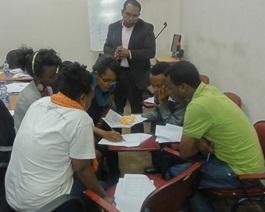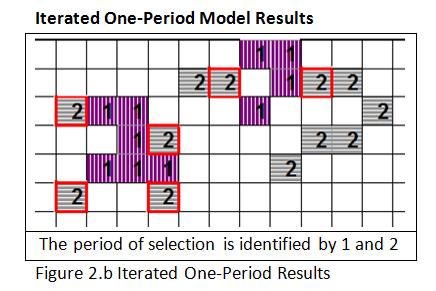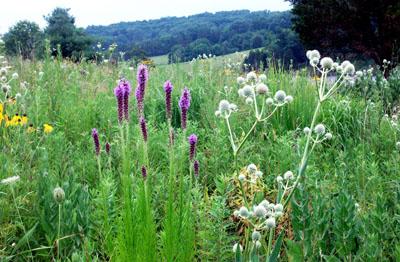My research is also influenced by the students I work with and has extended to topics in energy economics looking at the economic impacts from unconventional gas and oil and marine economics looking at preferenes for sustainable seafood. Part of the optimal land allocation work I engage in extends beyond conservation to look at optimal school districting.
My research is also influenced by the students I work with and has extended to topics in energy economics looking at the economic impacts from unconventional gas and oil and marine economics looking at preferenes for sustainable seafood. Part of the optimal land allocation work I engage in extends beyond conservation to look at optimal school districting.
Urban Greenspace: Use, Barriers, and Environmental Justice Implications
As part of a multiyear project funded by the U.S. Forest Service, Portland State University,and the PSU-Institue for Sustainable Solutions, I am working with Randy Bluffstone at PSU to understand use, preferred amenities, and barriers to use of urban greenspace and how these vary by socio-demographic factors. I led the creation of a survey and a choice experiment that was conducted in August 2020. Preliminary results find strong evidence of differences in use, preferred amenities, and barriers by socio-demographic factors.
Cascade Tank Systems in Sri Lanka: Preferences for Restoration
One of the most novel research projects I am engaged in explores an ancient irrigation system known as cascading tank systems, that was established in parts of Asia over 2000 years ago. The cascading tanks were designed to use the natural landscape and store water for use in the dry season for agriculture and human use. The cascading tank system in Sri Lanka, a 2000 year old system of approximately 15,000 small tanks continue to provide irrigation for about 200,000 hectares (25% of the total irrigable area). Over the last few centuries, the structure of the cascade tanks and the hydrologic system connecting the tanks have slowly deteriorated due to lack of maintenance and the disappearance of the traditional community institutions that were responsible for the cascade tank system.
In this research, which started as a collaboration with IUCN-Sri Lanka and was conducted with Shamen Vidanage as part of his PhD dissertation research, we use a choice experiment survey to understand preferenes and the willingess to pay for cascade restoration from rural and urban respondents. We then use the results of the choice experiment to conduct a cost-benefit analysis of cascade restoration and find that cascade restoration improves welfare (a CB ratio of 1.6 for just paddy benefits and 3.2 for all benefits including non-market benefits).
The first peer reviewed output of this work is a book chapter , "Choice Experiment Analysis of Non-market Values of Ecosystem Services: Cascade Tank Systems in Sri Lanka" is published in Agricultural Policy Analysis by Springer as an output of the EU-TAMAP project. https://link.springer.com/chapter/10.1007/978-981-16-3284-6_13
Dynamic Reserve Design
I create a dynamic reserve design framework that can analyze the impact of location based amenity price effects on optimal site selection for conservation reserves. This work is done in collaboration with Hayri Onal and I presented the research at multiple conferneces including the WCERE 2010, the AAEA Annual Meeting and the pERE Seminar.
The first paper stemming from this research titled, "Amenity Driven Price Effects and Conservation Reserve Site Selection: A Dynamic Linear Integer Programming Approach" is published in Ecological Economics. doi:10.1016/j.ecolecon.2011.06.015.
Preferences for and Opportunity Costs of REDD+ Contracts and Community Managed Forestry
I conducted a choice experiment survey of residents in rural Ethiopia and Nepal to understand preferneces and willigness to adop REDD+ contracts. This work is part of a larger collaborative effort between multiple institutions including ForestAction in Nepal, the Enviorenmental Economics Program for Ethiopa (EEPFE), Portland State University, the World Bank and University of Gothenberg and aims to understand the preferneces for, opportunity cost of and trade-offs among attibutes in REDD+ contracts. Resuls from this work has been presented at multiple department seminars, at international meetings and conferences including the WCERE 2014 and dissemination workshops including a REDD+ Workshop in Nepal in June 2014 and a REDD+ Workshop in Ethiopia in December 2014.
The first paper from this work is published in the Journal of Forests and Livelihoods. The work has also resulted in multiple World Bank Workin Papers (available here-Nepal and here-Ethiopia and multiple Policy Briefs that are available here.
Understanding Public Peferences for Ecosystem Restoration
Grasslands in Illinois: I use a choice experiment (conjoint analysis) survey of Illinois residents to understand public preferneces and WTP for restoring grasslands. In addition, the research analyzes how the prescence of substitutes impact preferences and studies the trade-offs among conservation attributes. This work is done in collaboration with Amy W. Ando and I presented the work at the inaugural AERE Summer Conference, the pERE Seminar, and the AAEA Annual Meeting.
The first paper from this research is published in Land Economics titled Valuing Grassland Restoration: Proximity to Substitutes and Trade-offs among Conservation Attributes. doi: 10.3368/le.90.2.237.
Coral Reefs in Okinawa: With Payal Shah, a researcher at the Okinawa Institute of Science and Technology, I have been conducting a choice experiment survey in Okinawa, Japan to understand preferences for creating marine proected areas aimed at protecting coral reefs. In addition to understanding preferences we also study how the institutional arrangements, specificall top-down and botom-up management of the protected areas impact respondents' choices.
A preliminary analysis of the data was conducted by Nils Carlson '15, who presented this work at the Colby Libearl Arts Symposium in 2015 and submitted a paper to the Journal of Environmental and Resource Economics at Colby (JEREC). We are currently completing a manuscript and a book chapter to share the full results from this work. .
Riparian Tree Shade Program in Oregon: Thermal pollution, the degradation of water quality due to the change in water temperature, is increasingly seen as a pollutant that can have a significant impact on the local ecosystem. An environmentally friendly solution that has recently garnered a lot of interest is the use of riparian buffers to provide tree shade to naturally reduce thermal pollution. I am working with Clean Water Services and colleagues at Portland State University to understand the public’s willingness to pay for the additional ecosystem services generated by the restoration of riparian forest lands. .
Part of this work resulted in a Master's Thesis in Environmental Management for Rondi Schei, who presented preliminary results at the NAREA Annual Meeting in 2013. The final data were analysed by Gilbert Kigundu '15, who presented resutls at the 2014 Heartland Workshop, the Colby Liberal Arts Symposium and the Maine Econnomics Conference in 2015. We are currently completing a manuscript from this work.
Spatal Considerations and Multiple Land Use in Reserve Design
I study the optimal allocation of land for conservation using spatial mathematical models that incoporate both economic and ecological considerations and consider alternate land uses. This work is done in collaboration with Hayri Onal, research scientists at US Army ERDC CERL, land managers from Ft. Benning GA and Ft. Stewart GA. This work has been presented at multiple conferences including the AAEA Annual Meeting, SEA Annual Meeting, and the SHAPE Summit.
This work ongoing work has so far produced two published papers, a book chapter, and three technical reports.
Optimum Selection of Clustered Conservation Areas for Species Relocation. Ecological Modeling. Vol 224 Iss 1. 65-75. doi:10.1016/j.ecolmodel.2011.07.016
Optimum Selection of Conservation Reserves: Extensions to Multiple Land Use. Military Operations Research, Vol 16, No. 1. doi:10.5711/1082598316165.
Optimal selection of clustered conservation lands using integer programming: the case of Fort Stewart in Georgia, USA. Handbook on the Economics of Ecosystem Services and Biodiversity, 193. doi.org:10.4337/9781781951514.00018
Optimal Taxation of Inter-related Environmental Externalities
I am currently working on a Genereal Equiblirium model that analyzes the optimal taxation given interrelated environmental externalities. The paper studies the optimal allocation of land for conservation given the use values and non-use option and existance values in a world where the use of the environment creates congestion. This work is done in collboration with Hector A. Nunez and the research has been presented at the AAEA Annual Meeting and the SHAPE Summit. You can download the working paper in the working paper section here.
Using STELLA Simulation Models to Teach Natural Resource Economics
STELLA simulation models can be used when teaching undergraduate natural resource economics classes to allow students to gain an intuitive understanding of economics policies. This working paper presents my experiences in using STELLA models in a natural resource economics class. You can download the working paper in the working paper section here.
If you are interested in incoporating STELLA simulation models indo a natural resource economics class that you are teaching I am willing to share the models that I currently have.
Preferences for underutilized seafood and socially sustainable seafood
This work involves two projects both of which are collaborations with Loren McClenachan, a marine ecologist at Colby College, and a group of Colby Students. The first project was done with Taylor Witkin '14 and involved using a choice experiment survey to understand preferences for underutilized sea food. This project was Taylor's honors thesis and the resulting paper was published in Fisheries Research.
The second project is supported by a grant from the Goldfarb Center for Public Affairs and Civic Engagement and uses a choice experiment to evaluate preferences for sustainable seafood labels that incorporated information about social sustainability (in addition to ecological sustainability). This work led by Jackie Chen '16 and both Economics and Environmental Studies students.
Resutls stemming from this work has been presented (by students) at the Colby Undergraduate Summer Research Retreat, the Colby Libearl Arts Symposium, the Maine Economics Conference, and NAREA Annual Meeting.
Energy Economics - Economics Impact of Fracking
This work investigates the local economic impact of shale gas development using the natural experiment of a discontinuity in regulation brought on by New York's 2008 moratorium on fracking. Using county and zip code level data from 2001-2013 to examine differences across New York and Pennsylvania counties before and after the moratorium, we find that shale gas development has a positive impact on employment and wages in the natural resource, mining, and construction sectors for the counties in which drilling occurs. However, we find an offsetting reduction in employment in the manufacturing sector. Overall we find no statistically significant effects from shale gas development on total employment and wages at the local level.
This work is part of the honors thesis conducted by Brendan Cosgrove '15 and was co-supervised by Dan Lafave, Michael Donihue. Brendan presented this work at multiple forums at Colby and also at the NAREA Annual Meeting in 2014. This work is published in Agricultural and Resource Economics Review (ARER).
Publications (Peer Reviewed)
Blackman A., Dissanayake S. T. M., Martinez Cruz A. (2023) The benefits of titling indigenous communities in the Peruvian Amazon: A stated preference approach. Land Economics. Forthcoming.
Albers, H. J., C. H. Chang, S. T. M. Dissanayake, K. J. Helmstedt, K. Kroetz, B. Dilkina, I. Zapata?Mor´an, C. Nolte, L. M. Ochoa?Ochoa, and G. Spencer. (2023). Anticipating anthropogenic threats in acquiring new protected areas. Conservation Biology. Forthcoming.
Dissanayake S. T. M., Vidanage S. (2023). Valuing ecosystem services from restoring ancient irrigation systems: An application comparing labor vs. monetary payments for choice experiments. Agricultural and Resource Economics Review. 52(2), 422-449.
Netusil, N. R., Dissanayake, S. T. M., Lavelle, L., Ando, A. W. & Wells (2023). Does presentation matter? An analysis of images and text in a choice experiment of green roofs. Q Open 3 (1).
Netusil, N. R., Lavelle, L., Dissanayake, S., & Ando, A. W. (2022). Valuing the public benefits of green roofs. Landscape and Urban Planning, 224, 104426.
Hardy, C. L., C. E. De Rivera, L. L. Bliss-Ketchum, E. P. Butler, S. T. M. Dissanayake, D. A. Horn, B. Huffine, A. M. Temple, M. E. Vermeulen, H. Wallace and J. Karps. 2022. Ecosystem Connectivity for Livable Cities: a Connectivity Benefits Framework for Urban Planning. Ecology and Society. 27 (2):36.
Butler, E. P., Bliss-Ketchum, L. L., de Rivera, C. E., Dissanayake, S., Hardy, C. L., Horn, D. A., ... & Wallace, H. (2022). Habitat, geophysical, and eco-social connectivity: benefits of resilient socio-ecological landscapes. Landscape Ecology, 37(1), 1-29.
D. LaFave, A. D. Beyene, R. Bluffstone, S. T. M. Dissanayake, Z. Gebreegziabher, A. Mekonnen, M. Toman. (2021) Impacts of Improved Biomass Cookstoves on Child and Adult Health: Experimental Evidence from Rural Ethiopia. World Development. V-140, 105332
Dissanayake S. T. M., S. Jacobson. (2021) Money Growing on Trees: A Classroom Game about Payments for Ecosystem Services and Tropical Deforestation. Journal of Economic Education. 52:3, 192-217.
Wang Y., H. Önal, S. T. M. Dissanayake. (2021). Delineating conservation areas for cohabiting species: An example of vernal pond conservation from Fort Stewart in Georgia, USA. Frontiers-Ecol&Evol, 9:702831
B. Abidoye, S. T. M. Dissanayake, S. Jacobson. Seeds of Learning: An Ecosystem-based Adaptation Classroom Game. (2021) Applied Economics Teaching Resources. 21.V3.
Y. Wang, Q. Fang, S. T. Dissanayake , H. Onal (2020). Optimizing conservation planning for multiple cohabiting species. PLOS ONE, Accepted.
S. T. M. Dissanayakec and A. G. Meyer. (2020). Incorporating Beliefs and Experiences into Choice Experiment Analysis: Implications for Policy Recommendations. Applied Economic Perspectives & Policy, 3039.
Shah, P., Dissanayake, S. T., Fujita, Y., & Nunes, P. A. (2019). Impact of a local, community-based management regime when defining marine protected areas: Empirical results from a study in Okinawa, Japan. PLOS ONE, 14(3)
L. McClenachan, R. Matsuura, P. Shah, S. T. M. Dissanayake (2018) Shifted baselines reduce willingness to pay for conservation, Frontiers in Marine Science. 5, 48.
M. K. Hennessey and S. T. M. DissanayakeC. Conservation Choices in the Face of Sea-Level Rise: A case-study from Maine (2017) Agricultural and Resource Economics Review – 46(2), 388-419.
R. Matsuura, S. T. M. Dissanayake, A. G. Meyer (2016) The Proposed Park in Maine's North Woods: Preferences of Out-of-State Visitors, Maine Policy Review 25.1: 54 -62
S. T. M. Dissanayake and S. Jacobson. (2016) Policies with varying costs and benefits: A land conservation classroom game, Journal of Economic Education. 47:2.
L. McClenachan, S. T. M. Dissanayake, and X. Chen. (2016) Fair trade fish: Consumer support for seafood sustainability, Fish and Fisheries.
H. Önal, P. Woodford, S. Tweddale, J. Westervelt, M. Chen, S. T. M. Dissanayake, G. Pitois. (2016) A Dynamic Simulation/Optimization Model For Scheduling Restoration Of Degraded Military Training Lands, Journal of Environmental Management. pp. 144-157.
H. Onal, Y. Wang, S. T. M. Dissanayake, and J. D. Westervelt. (2016) Optimal Design of Compact and Contiguous Conservation Management Areas, European Journal of Operational Research. 251 (3).
S.T.M. Dissanayakec. (2016) Using STELLA Simulation Models to Teach Natural Resource Economics, Journal of Economic Education. 47:1.
B. Cosgrove, D. LaFave, S. T. M. Dissanayakec, M. Donihue. (2015) The Economic Impact of Shale Gas Development: A natural experiment along the NY and PA border, Agricultural and Resource Economics Review. Vol 44 Iss 2. 20-39.
S.T. M. Dissanayakec, P. Jha, B. Adhikari, R. Bista, R. Bluffstone, H. Luintel, P. Martinsson, N. Paudel, E. Somanathan, and M. Toman. 2015. Community Managed Forest Groups and Preferences for REDD+ Contract Attributes: A choice experiment survey in Nepal. Journal of Forests and Livelihoods. Forthcoming.
T. Witkin, S. T. M. Dissanayake, L. McClenachan. 2015. Opportunities and barriers for fisheries diversification: Consumer choice in New England. Fisheries Research. 168, 56-62.
S. T. M. Dissanayake and A. W. Ando. 2014. Valuing Grassland Restoration: Proximity to Substitutes and Trade-offs among Conservation Attributes. Land Economics. 90(2), 237-259.
S. T. M. Dissanayake, H. Önal, J. D. Westervelt, and H. Balbach. 2012. Optimum Selection of Clustered Conservation Areas for Species Relocation. Ecological Modeling. Vol 224 Iss 1. 65-75.
S. T. M. Dissanayake, and H. Önal. Amenity Driven Price Effects and Conservation Reserve Site Selection: A Dynamic Linear Integer Programming Approach. 2011. Ecological Economics. Vol 70, No 12, 2225-2235.
S. T. M. Dissanayake, H. Önal, and J. D. Westervelt. 2011. Optimum Selection of Conservation Reserves: Extensions to Multiple Land Use. Military Operations Research, Vol 16, No. 1.
B. C. Daniels, S. T. M. Dissanayake, and B. R. Trees. 2003, Synchronization of coupled rotators: Josephson junction ladders and the locally-coupled Kuramoto model, Physical Review E, Vol 67.
Other Publications (Not Peer Reviewed)
S. T. M. Dissanayake. My Journey Through the US Undergraduate System – Part I and Part II. The Sunday Observer and SL2College. Spring 2011.
V. Kudaligama and S. T. M. Dissanayake. Sri Lanka’s Peace Dividends: The End of the War and Beyond. The Illinois International Review. Fall 2009.
Dissanayake, S. T.M., Önal, H., Westervelt, J. D., & Balbach, H. E. (2014). Optimal selection of clustered conservation lands using integer programming: the case of Fort Stewart in Georgia, USA. In Nunes, P. A., Kumar, P., & Dedeurwaerdere, T. (Eds.). (2014). Handbook on the Economics of Ecosystem Services and Biodiversity. Edward Elgar Publishing. 193.


